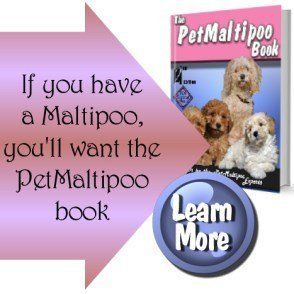Maltese VS Maltipoo Dogs
Interesting Differences Between Maltese and Maltipoo Dogs
For owners that already know the main difference between these two dogs but are looking for some new, interesting information and for those simply curious about this, this section is going to cover all of the various differences and similarities between Maltese and Maltipoo dogs.
We will go over:
- What separates a purebred from a hybrid dog
- Side-by-site Stats
- Differences in coat, color, size and more
- Breed specific health
- Grooming requirements
- Care overviews
Please note:
PetMaltipoo is reader-supported. Some of the product suggestions on this page are affiliate links. As an Amazon Associate we earn from qualifying purchases. This is at no extra cost to you and helps us continue creating useful content.
Maltese VS Maltipoo - Purebred vs Hybrid
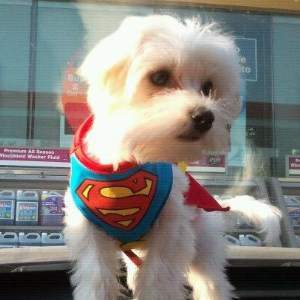
A really adorable Maltese fitting the AKC standard quite nicely, Buddy (3 years old) Photo courtesy of owner Stephanie Agostino
Maltese -
The Maltese breed is a purebred dog. While most purebreds are registered, technically a dog does not need to be registered in order to be a purebred. It is his bloodline and his genes that make him so. In order for a dog to be considered 'purebred' he/she must be a descendant of known purebreds of the same breed.
Since dog clubs and registries were formed, one of the main purposes was to have each breed maintain a strict standard in regard to appearance. This is a guideline that dictates the expected size of the dog, coloring, ear set, tail set and so forth. As new puppies are being born from purebred parents, this gives the breed a consistent appearance.
With the Maltese, aside from simple AKC guidelines
such as 'weight under 7 pounds with 4 to 6 preferred' and 'black nose', there are some very detailed expectations such as 'muzzle is of medium length, fine and tapered but not snipy' and 'The chest is fairly deep, loins taut and strong, slightly tucked up underneath'. And even expected personality such as '...he is lively and playful as well as vigorous' and the way the dog should move 'jaunty, smooth, flowing gait' is included in the breed standard.
While there are always some variations, in general a Maltese will always look like a Maltese even if the dog has 'faults' such as too dark of a color or is outside of the standard weight range.
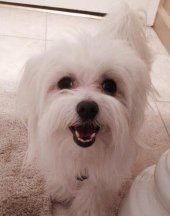
A super cute Maltipoo, that looks very much like a Maltese, due to the white coat and black nose. Bella (2 years old), Photo courtesy of Dennise (San Fran bay area)
Maltipoos -
The Maltipoo is a hybrid dog. Technically, hybrid means the crossing of two different animals that have genomes similar enough for them to successfully mate (for example mule and horse)… However, this term is applied to a dog that is the result of two known purebred dogs. There are 1st, 2nd and 3rd generation Maltipoo dogs.
A first generation is the result of a purebred Maltese with a purebred Poodle; most often a toy Poodle will be used for the crossing, though some breeders will use a miniature Poodle. A second generation Maltipoo is the result of breeding together 2 Maltipoos that are each 1st generation (both had one Poodle parent and one Maltese parent). A 3rd generation is the pairing of two 2nd generation Maltipoos.
You may wonder why the Maltipoo, which is such a popular dog, is not yet accepted by the AKC or if this will ever happen. Every single accepted breed was developed by crossing together other breeds; this is how different dogs were developed. And this is what is happening with Maltipoos. However, this is a very long process.
It can take several hundred years for enough ethical breeding to be done, for the dogs to have a set and expected appearance. Currently, Maltipoo dogs do not have a set appearance as the Maltese does; the majority of them lean more toward looking like a Maltese and the minority of them appear to have more Poodle in them.
Eventually a particular 'look' will hold (expected hair texture, nose color, etc) and that will be a huge step toward future recognition.
Maltese and
Maltipoo
Stats
Pronunciation: Mall-TESE
MAULT-eh'-Poo
Alternative Names: Maltese Terrier
Moodle, Malt-A-Poo, Multapoo, Multipoo, Malte-Poo
Weight: 4 -7 lbs (1.81 - 3.18 kg)
5-12 lbs (2.27-5.44 kg)
Height: 8 - 10 inches (20.32 - 25.4 cm)
8 to 14 inches average (20.32 to 35.56 cm)
Size Class: Toy Toy
Life Span: 12-15 years; 13.5 on average
12 to 16 years; 14 on average
Maturity: 1 year
1 year
Origin: Malta - A small island in the Mediterranean Sea US/UK/ Other
Date of Origin: 1400 BC or earlier
If one day accepted, credit will go to both ancestors: the Poodle and Maltese with the popularity of the crossbreeding becoming popular in the 1990's
Colors: White with lemon or tan on ears permissible
All colors
AKC, FCI and CKC recognized: Yes
No
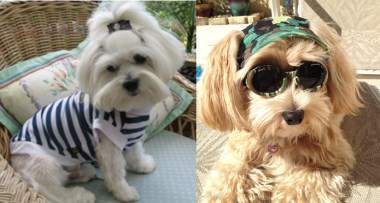
Left:
Maltese; Albi, 2 years old, photo courtesy of Margaret Mohamed
Right:
Maltipoo, Isabella, 2 years old, photo courtesy of Kathy Nichols
Origin
The Maltese
is an ancient breed, thought to originate in the Mediterranean area and its name stems from the Mediterranean island of Malta where small white dogs were revered. These dogs were eventually transported into Egypt and Europe. It is believed that over centuries, the dog was bred down in size and we do know that in the 1600's and 1700's, selective breeding was done to make the Maltese smaller.
Maltipoo lovers that understand about crossbreeding should find it interesting that in the early 1800's, there were very few Maltese dogs and at that time these dogs were crossbred with Poodles and miniature Spaniels to help keep the breed from going extinct. This created at least 9 different types of Maltese dogs; some of which had color.
In the early 1900's both parti-color (two colors) and fully solid colored Maltese dogs were accepted in UK show rings. It is only relatively recently that Maltese have been expected to be pure white (with tan or lemon markings on the ears being acceptable with some kennel clubs). The Maltese was accepted by the AKC in 1888 and by the FCI in 1955 (with Italian patronage).
The Maltipoo
is a hybrid dog, being either a cross of a toy or mini Poodle and a Maltese or is produced by pairing two Maltipoos. As noted above in looking at Maltese history, crossbreeding is not unique to just' hybrid' dogs, as every purebred was crossbred at some point. Some crossings are unknown due to poor record keeping and others are well documented. This sort of selective breeding
has been happening since dogs were domesticated, yet only starting in the late 1900's did the terms of 'hybrid' and 'designer' dogs gain popularity.
Some hybrid dogs did not catch on and others did. The Maltipoo is one of the most popular hybrid dogs and if ethical breeders keep working towards a standard appearance, it is possible that someday Maltipoos will be an accepted breed. The AKC, FCI and other large kennel clubs accept new breeds every few years that were once 'hybrid' dogs.
For example, in 2011 the Boerboels dog was accepted in the Miscellaneous class (most dogs enter here and after 2 to 3 years, move to being an accepted purebred) and this dog was crossbred with Bullmastiffs in the early 1900's.
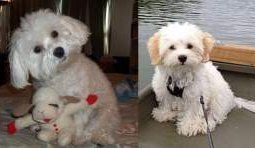
Left:
Maltese, Kirby, photo courtesy of the OMelia/Neidermeyer family
Right:
Maltipoo, Mace, photo courtesy of Bobbi Allen
Face Shape Comparison
It is very interesting to note that just about every Maltipoo has a muzzle similar to the Maltese and not the Poodle. Poodles have long, narrow snouts, as described by the AKC as 'long, straight and fine, with slight chiseling under the eyes'.
You'll notice that with the majority of Maltipoo that you see, the snout (and also the forehead) are quite similar. Maltese have moderate snouts, as defined by the AKC as ''of medium length...but not snipy', with 'snipy' meaning pointy. The way in which the facial hairs fall on each dog plays a role in how this appears as well.
The skull is 'slightly rounded' and ears are drop ears (those that hang by the side of the face) and set low (the base is to the side of the head, not on top). And since many Maltipoo dogs have these same facial structures, it's easy to see the Maltese influence. As more and more Maltipoo are bred to each other, this may very well be one feature that defines the dog.
Differences in Coat
With Maltese and with many Maltipoo dogs, any notable dissimilarity will depend on the length of the coat.
Maltese are a single coated breed and how the hair lies depends on its length. If the coat is allowed to grow long (a show dog coat), the weight of that long hair will create a long, flowing coat of straight hair
and this is enhanced with certain grooming products. If a Maltese has a short (ish) puppy coat trim, the hairs will be wavy. In either case, the coat is soft and silky.
Maltipoos, on the other hand, have both Maltese and Poodle genes affecting the coat. The Poodle also has a single layer of hair; however it is dense, curly and somewhat water resistant. Many Maltipoo dogs have slight to moderately wavy hair; this is a result of more Maltese genes influencing the coat… the more curls, the more Poodle there is.
There are some Maltipoos that have super curly coats more similar to Poodles and if this occurs it is not due to 'bad breeding' or any other such element and is simply due to taking after the Poodle parent instead of the Maltese in regard to the coat. Second generation Maltipoo (both parents are first generation) are more apt to have the soft wavy textured coat.
While it may be hard to see in photos, if you were to touch the hair of a Maltese and a Maltipoo, in many cases, the Maltese would feel a bit silkier; though this also depends on the grooming
products that are used.
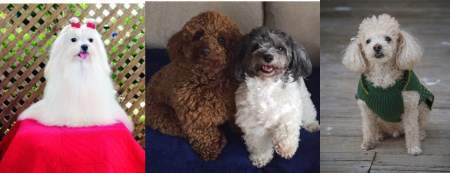
Left:
A Maltese with a long, straight show coat
Middle:
Two Maltipoo dogs; Benedict (left) has a curly Poodle coat. Francesca (right) has a more wavy coat. Photo courtesy of Sharon Lundgren
Right:
A Toy Poodle with the classic curly coat of hair
Size Differences
Both Maltese and Maltipoo dogs are considered to be in the Toy size class. The Maltese, being recognized, is officially a toy sized dog with his weight of 4 -7 lbs (1.81 - 3.18 kg). The Maltipoo, although not recognized, does fit this classification. The smallest toy is the Chihuahua with a top weight of 6 lbs. (2.72 kg) and the largest is the Pug with a weight of 14 to 18 lbs. (6.35 to 8.16 kg) Most Maltipoos range from 5-12 lbs. (2.27-5.44 kg), putting him correctly in the category of toy sized.
The size of a Maltipoo
depends on if a toy Poodle is a parent and what weight that dog was (6 to 9 lbs. - 2.72 to 4.08 kg) or a mini is one of the parents (15 to 17 lbs. - 6.8 to 7.7 kg).
Since most Maltese will only be 7 lbs. at the most and some Maltipoo are as tiny as 5 lbs., there are some Maltipoo that are smaller than Maltese dogs. However, since many Maltipoo dogs are typically in the 8 to 10 pound range(3.62 to 4.53 kg) and they can grow to be as large as 12 lbs. (5.44 kg). (these are often the ones that have a miniature Poodle as a parent), the majority of Maltipoo will be slightly larger than Maltese dogs.
In regard to height, which is measured from the withers (the top of the shoulder blades) to the floor, both Maltese and Maltipoo have a starting range of 8 inches (20.32 cm). Maltese can mature to be as tall as 10 inches (25.4 cm) and Maltipoos may be a bit taller, sometimes as tall as 14 inches (35.5 cm).
So, on average, a Maltipoo may be slightly larger than a Maltese in both weight and height, however is still considered to be a small lap dog.
Differences in Color
This is another huge difference between these two types of dogs. While many people believe that Maltese are only found in pure, solid white they do actually can have a bit of coloring. Light tan or lemon may appear on the ears and due to some improper breeding practices, there are some Maltese that have a secondary color on other areas beside the ears. A previously white coat that has gradually changed over to be yellowed or cream can often be attributed to improper bathing products (shampoo and conditioner) and can often be corrected. At any rate, color is limited for this breed.
The Maltipoo, however, thanks to the Poodle's influence, can be found in a wide range of colors. Any color that is found with Poodles can appear on a Maltipoo. However, in most cases the white of the Maltese will water down or lighten the coloring.
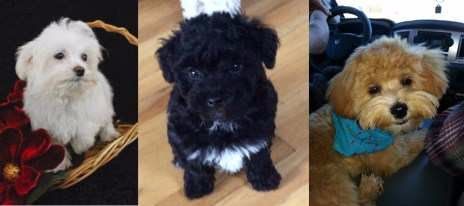
Left:
A standard all-white Maltese
Middle:
A black with white markings Maltipoo (Blue, 8 weeks old, photo courtesy of Sharon Lundgren)
Right:
An apricot Maltipoo (Boomer, 9 months old, photo courtesy of Donna)
Personality
When you read about a dog's character and temperament, it is important to note that these are general statements and that each dog has his/her own unique personality. How a dog is raised plays a huge role in his behavior and general disposition.
Maltese, per the AKC, are described as charming, gentle and playful and this certainly holds true for many Maltese dogs. In regard to the Maltipoo, we must look at the other gene influence: the Poodle. That breed is described, per the AKC, as active, smart and very proud. This is true of many Poodles and the 'very smart' description certainly is accurate since Poodles are considered one of the most intelligent breeds in the world. According to the Intelligence of Dogs, a book published in 1994 yet still serving as the main reference for canine intellect, this breed places 2nd. The Maltese places 59 out of 79 (though it must be noted that this is only one conclusion based on Professor Stanley Coren's poll questions sent out to AKC and CKC (Canadian Kennel Club) trial judges.
Most Maltipoos are very friendly, outgoing and personable dogs with high loyalty to owners and a good record of being obedient. Puppies
of both breeds are quite outgoing and energetic, often calming down as they reach the 12 to 18 month old range. Adult Maltese dogs can tend to be rather mellow and calm… and some Maltipoo (thanks to the Poodle influence) can be a bit more active and outgoing than Maltese.
Both typically get along very well with children and other dogs, yet may be a bit wary of strangers and may need some time to warm up to them. Due to their strong bonding capabilities, both Maltese and Maltipoo dogs can struggle when left home alone and may have some separation anxiety issues.
Trainability
Both breeds are essentially equal in regard to ability to be trained for housebreaking and commands. Having a good plan, having all family members stick to a training schedule and an owner's enthusiasm will all play a role in how quickly a puppy is trained and how successful a dog will be with commands.
Health
Maltese dogs are most prone to:
- Eye conditions - This includes aberrant cilia, which is a condition in which the eyelashes grow abnormally, cataracts and glaucoma.
- Hydrocephalus - A birth defect that causes excess in fluid surrounding the brain. Severe cases may cause loss of coordination, vision problems, misshapen skull and/or seizures.
- Luxating patella -Abnormal kneecap development; the kneecap slips out of place.
- Collapsed trachea - The rings of cartilage surrounding the windpipe collapse inward.
- Hip dysplasia - A slippage of the hip joint and socket.
- Liver shunts - Malfunctioning blood vessels of the liver.
- Hypoglycemia -Low blood sugar levels.
- White Shaker Dog Syndrome - Found more often in white dogs than those of other coat colors, a type of seizure disorder.
Maltipoo dogs:
One of the benefits of hybrid dogs like the Maltipoo is that hybrid vigor
may
lead to a healthier dog. Though some will exaggerate the extent of how hybrid vigor works, typically it will reduce the odds of some health issues; it has not been proven to completely eliminate any conditions. Studies have found that crossbreeds are less likely to develop: cataracts, allergic dermatitis, elbow dysplasia and portosystemic liver shunts, among other issues. Nevertheless, Maltipoos are prone to many of the same conditions as Maltese:
- Eye conditions
- Luxating patella
- Collapsed trachea
- Hip dysplasia
- Liver shunts
- Hypoglycemia
- White Shaker Dog Syndrome

Left:
Maltipoo, Midge, photo courtesy of owner DiAne Gordon
Right:
Maltese, Albi, photo courtesy of owner Margaret Mohamed
Grooming Requirements
Shedding -
Both breeds have a single layer of hair. This means that shedding is very minimal for both Maltese and Maltipoo dogs. However, the coat is in a constant state of renewal; this is true for all dogs that have hair and not fur. Every hair follicle is in a certain state: Growth, rest or fall out. So, just like hair on a human's head, some will fall out each day. Therefore any breed of dog that is classified as a 'non shedder' will have natural hair loss; though this is not to the degree of heavy shedding dogs that can leave clumps of fur behind.
Coat care -
When a dog has a single coat, like both the Maltese and Maltipoo have, improper coat care often affects the skin more than dogs that have thick, dense fur. Both breeds should be bathed once every 3 weeks with a high quality shampoo and conditioner. With both Maltipoo dogs that have a soft, wavy coat and Maltese dogs, a light leave-in conditioner should be applied both after baths and approximately every 3 days.
This is needed to protect the hair from contact friction, sun damage and other elements that can dry out the hair and cause split ends. Owners of Maltese with long show coats must have dedication and time to care for the coat, which must be groomed often to prevent tangles, with extra care being given to keeping split ends at bay which can prevent growth. If a Maltipoo has a curlier coat (like a Poodle) a crème rinse is often used after bathing, as well as a more structured leave-in product.
For recommended grooming products (everything from nose butter to paw wax to super effective leave-in's, look to the Maltipoo Supplies page.
Other grooming elements -
Other grooming needs are essentially the same. Nails typically need to be trimmed every 4 to 6 weeks. Teeth should be brushed at home each day, using a high quality canine toothpaste and appropriately size toothbrush. Tear staining can be a problem for both breeds, though with Maltipoo that have colored coats (browns, grays, blacks), this may not be as apparent. For both breeds, wiping the area on a regular basis with a quality tear stain prevention wipe can help keep the area free from staining.
Care Needs
Three of the most important care elements apply to both
Maltese and Maltipoo:
1)
Use a harness when on leash.
Due to their small size and with collapsed trachea always a concern, it is best to avoid connecting a leash directly to the collar. If this is done, when the dog is walked and any time he jumps to the side, this puts pressure on the neck. Using a harness distributes pressure across the chest and back and can greatly reduce the chances of neck injury.
2) Stick to a feeding schedule.
Small dogs like the Maltese and Maltipoo are prone to hypoglycemia, which is a rapid drop in blood sugar levels. This is more apt to happen to young puppies; however it can develop quickly in a tiny dog of any age. While stress (such as moving to a new home) can cause this, one of the main contributors is inconsistent feeding, when the dog goes too long without food.
While some larger breeds can do just fine with one main meal per day, Maltese and Maltipoos need to eat more often. Puppies should have 3 meals per day plus healthy snacks. Adults should have 2 meals per day plus healthy snacks.
3)
Prevent chills.
It is common for toy sized dogs to shake and shiver and this is not usually due to nervousness; it is most often due to being cold. With a tiny body and only a single coat of hair, Maltese and Maltipoos can become cold quickly…and the best way to prevent this is to place a soft cozy sweater on your dog on cool/cold days.
For super cute clothes for Maltipoos, look to the Maltipoo Supplies page.
Summary
Both Maltese and Maltipoos are adorable toy sized dogs with happy dispositions and playful, friendly personalities. Being minimal shedders, they are both considered low-maintenance (though Maltese with long show coats do require more grooming care). Being so small also means that you'll be spending less money on food each year than you would with a large sized dog. Both breeds make wonderful canine companions, happy to live in a small apartment or a large home with multiple pets.
Things to do now:
Become a free Member
(if you are not already a Member) so that you'll receive a friendly reminder when we add new pages of information to this site. You can also suggest a topic for us to write about or ask a question.
Request your copy of the PetMaltipoo eBook
- The most comprehensive Maltipoo care book that exists. This is a 'must have' book for all Maltipoo owners.
More Helpful Articles:
Maltipoo Allergies
- Covers all 3 types (food, contact, seasonal), with exact steps to both reduce triggers and treat symptoms including itching, rash, and hot spots.
Maltipoo Puppy Care
- A great summary of what is needed to take optimal care of your new Maltipoo pup.


